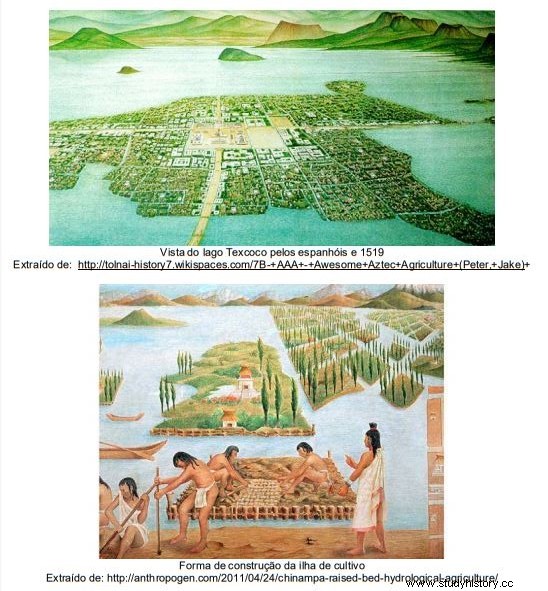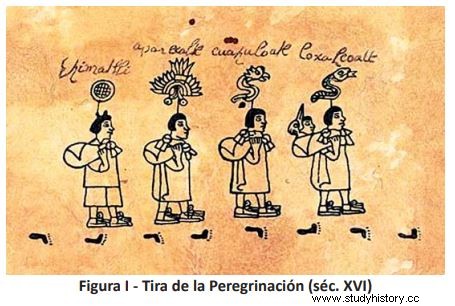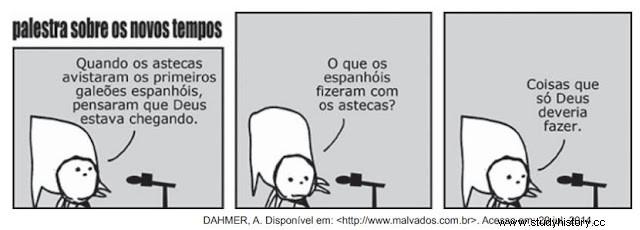Question 02 - UFRJ - The Aztec civilization had as its center the region that today corresponds to:a) Mexico; b) the Caribbean; c) the Pacific coast of the USA; d) to Peru; d) Venezuela.
Question 03 - UNESP - 2004/2 - 1st day - The so-called “Civilization” or “Aztec Empire” flourished in the region of the current Mexican plateau, until it was victimized by the Spanish colonization process. About the Aztecs, it is correct to say that a) they traded goods in the cities, but were unaware of the generalized use of money. b) practiced astronomical science, but did not know hieroglyphic writing. c) knew productive agriculture, but did not know weaving and goldsmithing. d) knew writing, but did not know pyramidal architecture. e) Cuzco was the capital of its Empire.
Question 04 - FUMARC - 2013 - CBM-MG - Look at the images and the text.

"And when we saw all the cities and towns built on water and other great cities on land drought, and that the built-up ground was straight and level, leading to Tenochtitlan, we were amazed. In fact, some of our soldiers wondered:if it wasn't all a dream." [Free translation (Spanish chronicler, Bernal Díaz del Castillo)]Based on what is known about Aztec culture and the images, it can be deduced that they represent(A) Calpulli.(B) Tlatoani.(C) Terraces.(D) Chinampas.
Question 05 - INEP - 2014 - ENADE - Degree in History - The production of writings that combined phonetic, logographic and ideographic glyphs with paintings was carried out for over two thousand years in Mesoamerica and is considered one of the defining characteristics of this macro-region.SANTOS, E. N. Historiographic uses of the Mixteco-Nahuas codices. History Magazine. USP. Sao Paulo, no. 153, 2005, p, 70.
 Available at:
Available at:A) I and II.B) I and IV. C) II and III.D) I, III and IV.E) II, III and IV.
Question 06 - UniCesumar Medicina 2018 - Military architecture naturally occupied an extensive domain of Aztec monumental art. Fortresses and fortified strongholds, garrisoned with towers, defended crossing points, such as, for example, the accesses that allowed crossing the lake.(In:SOUSTELLE, Jacques. Aztec civilization. Rio de Janeiro:Zahar, 1987)
From the text and historical knowledge, it can be said that, for the Aztec civilization, a) the power of the military oligarchy of the Aztec government gave the army great prestige. b) the wealth accumulated by the army in wars encouraged the development of artes.c) the participation of the army was very important for the conquest and defense of the Empire. d) the army was the main responsible for the development of the military force in the Empire. e) the main economic activity of the Aztec Empire was the war of conquest and domination.
Question 07 -UEL 1st PHASE 2009 - The Aztecs sacrificed prisoners of war to feed their gods. The captive had his heart ripped out, beheaded and had his blood drunk by the captor, who then took the body home, skinned it, ate it with corn and dressed its skin. It is correct to say that these rituals in the world of the Aztecs were of a symbolic nature, since:a) the vanquished had to pay a blood tribute to the Aztecs, who saw themselves as gods. b) the Aztec priests demanded blood offerings so that their temples would not lack food. c) a large number of sacrifices represented a reinforcement of the food supply, preventing famine. d) the captor of the prisoner took revenge on the enemy, eating his flesh and wearing his skin. e) the gods demanded offerings of the most precious good that men had, life, so that the world could be preserved.
Question 08 - UNESP 2017/2 - 1st phase - The gods said among themselves after creating man:“What will men eat, oh gods? Let's all go get the food.” Meanwhile, the red ants were harvesting and carrying the corn kernels they brought from inside the Tonacatepetl (Mountain of Sustenance). The god Quetzalcoatl found the ants and said to them:“Tell me, where did you gather the corn kernels?”. Many times he asked them, but the ants would not answer. Some time later, the ants said to Quetzalcoatl, “There.” And pointed out the place. Quetzalcoatl turned into a black ant and accompanied them. In this way, Quetzalcoatl accompanied the red ants to the warehouse, arranged the corn and then took it to Tamoanchan (abode of the gods and where man had been created). There the gods chewed it and put it in our mouths to strengthen us. (Apud Eduardo Natalino dos Santos. Pre-Hispanic Cities of Mexico and Central America, 2004.)
The Aztec text) promotes the dissemination of nutritional qualities of maize for the strengthening of Mesoamerican warriors. b) offers a mythical explanation for the importance of maize in the diet of Mesoamerican peoples. c) demonstrates historical support and a clear development of logical and rational thinking.d) seeks to justify the fact that only the rulers of Mesoamerican peoples can exercise agricultural activities.e) reveals the influence of European fables in the construction of the imagination of Mesoamerican peoples.
Question 09 - FATEC 2003/2 - The Aztecs gave the name Chinampasa) to houses made of adobe, built with several floors.b) to the water kennels used to irrigate the land in the desert regions of the coast. erosion.d) artificial islands formed with mud piled up and lined with grass and bushes. e) the land collectively owned by the tribe and divided by the clans.
Question 10 - FUVEST 2012 -When Bernal Díaz first sighted the Aztec capital, he was speechless. Years later, the words would come:he wrote a heartwarming account of his experiences as a member of the Spanish expedition led by Hernán Cortés to the Aztec Empire. On that November afternoon of 1519, however, when Díaz and his companions of conquest emerged from the gorge and first encountered the Valley of Mexico below, they saw a scene that, years later, they described thus:“we glimpsed such wonders that we didn't know what to say, or if what was before our eyes was real.” Matthew Restall. Seven Myths of the Spanish Conquest. Rio de Janeiro:Brazilian Civilization, 2006, p. 15-16. Adapted.
The text shows an important aspect of the conquest of America by the Spaniards, namely, a) the cultural superiority of Native Americans in relation to Europeans. b) the friendly character of the first meeting and the subsequent coexistence between conquerors and conquered. c) the surprise of the conquerors in the face of cultural manifestations of Native Americans. d) the recognition, by the natives, of the importance of cultural and commercial contacts with the Europeans. e) the rapid disappearance of the native cultures of Spanish America.
Question 11 - ENEM 2016 - When the first news about the presence of strange beings, arrived in boats as big as mountains, who rode on a species of huge deer, had big and ferocious dogs and had fire-throwing instruments, Montezuma and his advisors were thinking:on the one hand , perhaps Quetzalcóatl had returned, but on the other hand, they did not have this confirmation. PINSKY, J. et al. History of America through texts. São Paulo:Context, 2007 (adapted).
The question presented was inserted in the context of the arrival of the first Europeans to America, and its origin was related to the a) domain of religion and myth. b) exercise of power and politics.c) control of war and conquest.d) birth of philosophy and reason.e) development of science and technology.
Question 12 - FATEC 2009/2 - In the process of conquest, the Spaniards dominated and exploited the peoples of the Aztec Empire that formed a civilization that a) developed ingenious irrigation systems for agriculture, which made possible a great human concentration and a great social hierarchy. b) practiced the anthropophagic ritual on a daily basis, based on the belief that the enemy's flesh would awaken the warrior spirit of artisans and peasants. c) carved small stone constructions of irregular shape, as they were unaware of cutting techniques and had few notions of mathematics and geometry. d) had an egalitarian social structure, since each individual had an important role in society, with no privileges of any kind. e) adopted a kind of constitutional republic as a form of government, which guaranteed balance and harmony between the executive, legislative and judicial powers.
Question 13 -UECE 2011/2 - It is estimated that when the Spaniards arrived on the American continent, the Aztec capital, Tenochtitlán, had a population of about 200 thousand inhabitants. Rich and beautiful, it had several canals, through which ships loaded with goods sailed, and appropriate aqueducts to carry water from the mountains to the city. About this city it is correct to say that A) it was considered the sacred abode of the gods and became rich thanks to the donations received from all peoples. B) it grew and remained economically affluent thanks to the heavy taxes that were paid on goods by the defeated peoples. C) had an exuberant architecture thanks to the contribution of the Mayan people then submitted. D) grew significantly from the arrival of the Spaniards.
Question 14 - FMP 2015

What the conquerors in the service of the Spanish Crown did with the Aztecs who, according to the interpretation of the cartoon, constitute “things that only God should do”? (A) Before attacking the capital Tenochtitlán, they decimated the non-Aztec peoples who paid taxes to the Empire. (B) They murdered the native ruler who received them amicably because he believed he did not would be hostile. (C) They avoided the use of steel and iron weapons in order to prolong the suffering of the natives who were tortured to death. (D) They raped Aztec women to spread contagious diseases that they knew to be native to Europe and deadly to the natives.( E) They avoided major combats on land, through the use of war cannons, fired from ships moored in coastal ports.
Question 15 - ENEM 2013 - The sad song of the conquered:the last days of Tenochtitlán Broken darts lie on the paths; the hairs are spread out. Unroofed are the houses, Red are the waters, the rivers, as if someone had dyed them, Our shelter was in the shields, but the shields do not stop the desolation... PINSKY, J. et al. History of America through texts. São Paulo:Context, 2007 (fragment).
The text is an Aztec record, whose meaning is related to the tragedy caused by the destruction of the culture of this people. b) failed attempt to resist a power considered superior. c) extermination of indigenous populations by the Spanish Army. d) dissolution of memory about the deeds of their ancestors. e) prophesying of the consequences of the colonization of America.
BACKGROUND 01 - E02 - A03 - A04 - D05 - B06 - C07 - E08 - B09 - D10 - C11 - A12 - A13 - B14 - B15 - B
